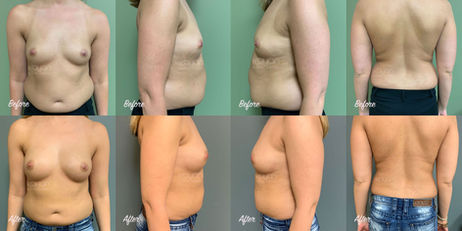
Free consultations. Call or text 612.756.8008
Breast fat transfer / grafting
$9,500 - $12,000
Varies by volume of fat transferred and number of areas liposuctioned.
Prices include surgeon, OR and anesthesia fee. Subject to change. Provided as an estimate and may be higher or lower depending on complexity.
WHO IS A GOOD CANDIDATE?
Patients who do not want to have breast implants and only want a modest size increase (usually 1 cup size or less) are good candidates for breast augmentation using their own fat. In addition to having enough breast tissue to graft the fat into, patients must have enough fat on their bodies to remove and graft into their breasts. There is no long-term maintenance required, unlike in the case of implants which will likely need to be switched out during a patient's lifetime. The patient will also see both an improvement in areas where fat is taken as well as an increase in breast size. During a fat grafting consultation, we will discuss areas where the patient would like fat removed, and what their sizing goals are. Dr. Kayan and her team will try and give you a realistic idea of what results can be achieved, as well as give you an example of the corresponding implant size the patient would end up at after your fat transfer to the breasts. Some patients will choose to undergo more than one round of fat grafting to the breasts if their goal size cannot be reached with a single surgery. If multiple procedures are planned, the time between surgeries is usually 3-6 months at a minimum.
WHAT IS FAT GRAFTING / FAT TRANSFER?
Fat grafting is the term used to describe removal of fat from one part of the body and transplantation of this fat into another part of the body. Fat from one patient can only be used on that same patient and cannot be "donated" to another patient for fat grafting. The procedure itself consists of transferring very small "packets" or aliquots of fat into the recipient tissue. The principle is similar to that of a skin graft, as the small "packets" of fat receive their initial nutrition for staying alive from the surrounding tissues, and eventually survive by your body actually establishing and growing blood vessels to the new fat. In general, 50-75% of the fat transferred will stay, so if 100ml of fat is transferred to a certain part of the body, a patient can expect to retain 50-75ml at most after they are completely healed.
THE PROCEDURE
Fat transfer is done under general anesthesia at an outpatient surgery center. The surgery takes between 1½-3 hours, depending on how many areas are being liposuctioned as well as the volume of fat being transferred. Several 3-4mm incisions are made in the areas to be liposuctioned, then a solution consisting of local anesthetic and epinephrine is infused into your tissues to shrink the blood vessels and help with pain post operatively. Long, thin metal rods called cannulas are then used to remove fat into a sterile container. The fat is collected in this container, rinsed, and loaded into small syringes to be injected into the breasts via a 2-3mm incision on the underside of each breast. The incisions are closed with dissolvable sutures and dressings, and the patient will be wrapped in a compression garment.
RECOVERY
All dressings and garments can be removed, and the patient may shower after 24-48 hours. There are no stitches that need to be removed. Patients will wear the compression garment(s) 24/7 for 3-4 weeks to help with swelling from the liposuctioned areas. No compression or tight clothing should be worn over the breasts as pressure on the fat may restrict blood flow. The patient will be quite bruised and swollen for about 1-2 weeks. Sometimes the swelling in the fat injected and liposuctioned sites can remain, on and off, for several months. In general, after the first 4-6 weeks most of the acute swelling in the breasts will go away, but it takes a full 3 months for the breasts to settle at their final size after all the non-viable fat is reabsorbed by the body.
Before and after*
*actual patient(s)







